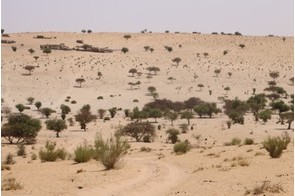Innovation as essential for climate change adaptation in agriculture

Summary
Genetic engineering, gene editing, and improved breeding techniques are some of the methods available to produce crops that resist climate stressors.
The global agreement at the climate pact COP26 summit in Glasgow last year highlighted the urgent need to prevent further temperature rises above 1.5C. For developing countries, the need to significantly reduce the emission of greenhouse gases (GHGs) was also emphasized. Although strategies to reduce emissions may seemingly help to limit future challenges stemming from global warming, they are not enough to stop the current impacts of climate change.
Apart from the possible inefficiency of the current climate change mitigation strategies, a new study by an international team of researchers from International Institute for Applied Systems Analysis (IIASA),Japan and the United States, published in Nature Food, reports the various risks on food security that could emanate from climate change mitigation strategies that excessively target the reduction of GHG in agriculture, forestry, and land use sectors.These strategies, which include large-scale afforestation, expansion of the cultivation of bioenergy crops,and additional cost of decarbonization – abating methane and nitrous oxide – could result in high competition for land.According to the study, implementing GHGs reduction measures in these three sectors could translate to 27 per cent increase in international food prices.
The three sectors (agriculture, forestry and land use) which play key roles in food security could be negatively impacted by stringent decarbonization measures. To avoid this untoward outcome, better approaches to GHG emissions reduction and improved agricultural market management policies need to be created.
It was estimated that an additional 120 million people could become hungry in developing countries as intensive afforestation could cause about 60 per cent increase in international food prices.Increased cost of reducing GHG emissions could also account for another 33 per cent food prices increment. On the global scene, the findings showed that an estimated 429 million people could be at risk of hunger by 2050. That is why it is essential for countries across the globe, particularly developing countries, to start adapting to climate change.
Climate change is a global phenomenon undeniably responsible for several climate-related catastrophes, including flooding, heat waves, prolonged drought, and conflicts which have greatly contributed to food insecurity, around the world. Adaptation strategies to tackle climate change involve adjusting our lives to a changing climate, majorly to lower our vulnerability to the adverse effects of these harsh changes. It also entails creating beneficial opportunities and making the most out of the current climate situation by mapping out innovative solutions and creating new markets for successful adaptation to climate change.
To be sure, the food system in many developing countries is not only affected by climate change. Other non-climate stressors, such as population growth, rural-urban migration, income growth, and increasing demand for non-indigenous food products,among others, negatively impact food availability, accessibility and ultimately food security. For the food system in developing countries of Africa and Asia to become resilient to climate-related stressors, we must develop technologies and interventions to secure it. It is not enough to develop these technologies; we must also ensure their widespread availability for food producers.
According to a recent report by the World Bank, a large share of technological innovations for climate change adaptation currently available are concentrated in the global North and China. Germany, China, Japan, the Republic of Korea and the United States altogether account for about 67 percent of all high impact inventions towards adapting to climate change filed for patenting between 2010 and 2015. Such technologies to increase resilience to extreme weather conditions can improve food production, distribution and utilization. They include improved drip irrigation systems and high quality crop hybrids specifically designed to withstand high temperatures, with low susceptibility to pests and diseases attack and can thrive despite irregular patterns of rainfall.
For the regions that are most vulnerable to extreme climatic conditions, advanced weather monitoring systems are needed to provide more accurate forecasts to tackle climate uncertainties in agriculture.
Technology Adoption
As much as possible, in developing countries, innovations and technologies to boost food security while adapting to climate change caused by global warming must be flexible and easily adaptable to local circumstances. Small scale versions of such interventions should also be made available to farmers and must be less capital intensive. When interventions are being developed in the global North for the developing world, it is important to bear in mind that the majority of food producers in the targeted regions are smallholder farmers who have to work on small areas of land and may not be able to individually afford technologies that could increase profitability in large plantations.
The demand for technologies that improve food production, processing and storage already exists in developing countries. However, for the interventions to sustainably meet the needs of target markets, they should not only be cost-effective but also low cost, to make them the choice solutions for food producers. One hindrance to successfully adopting technological innovations in the global South is the need for additional support to ensure proper installation, monitoring and maintenance, depending on the nature of the new intervention. Government agencies and institutions that are relevant to agriculture and the food sector should develop human capacity and the needed financial resources to provide technical support for sustainable use.
Role of Biotechnology
Genetic engineering, gene editing, and improved breeding techniques are some of the methods available to produce crops that resist climate stressors. These technologies are also important for livestock adaptation to climate crises. Enhancing the capacity of scientists in the developing world and providing required facilities and support for modern day innovations can increase the conception and development of useful climate adaptation interventions locally.
In Nigeria, for example, we already have some fantastic outputs, including genetically modified (GM) cotton and GM pod borer resistant beans known as “Bt cowpea”. Bt(Bacillus thuringiensis) cowpea was approved for open cultivation in the country by the National Biosafety Management Agency (NBMA) in January 2019, according to the Alliance for Science.Some Nigerian farmers have started growing this bean variety which produces good yield and at the same time reduce the cost of cowpea production, thereby making the protein-rich staple food more affordable. Bt cowpea needs to be promoted for widespread cultivation because the GM cowpea is not affected by reduced atmospheric moisture and other climate change-related conditions which have been causing poor yield of cowpea seeds.
Modification involving the introduction of a gene which confers protection to the crop, helps it (the crop) to withstand both biological and physical damages arising from adverse climatic conditions. Large scale availability of Bt cowpea in the country could help reduce the market price and make it accessible for households who rely on this plant-based protein source. Affordability is a crucial factor especially for low-income households.
With biotechnology tools, scientists are making available improved varieties to adapt to climate change; from cassava that resists diseases to cattle and poultry breeds that are more resilient to heat stress. Genome editing is making it possible to specifically change the genome of livestock to suppress or express various traits of interest.
Farming Efficiency
Production of improved food crops has increased farming efficiency, and also lowered the costs of food production – by limiting the dependence on pesticides – and overall maintenance of healthy plantation. The Council of Agricultural Science and Technology chaired by Brandon McFadden from the University of Delaware, USA, in a recently published article, stated that in 2016 alone, GM crops generated about $57 billion in farm revenue. It also highlighted that an additional $65 billion could have been generated, if GM crops were cultivated widely and with higher acceptance. Developing countries will reap more of the benefits if this happens soon.
Already, adoption of improved crops in the United States among other countries, in periods of challenging adoption rates between 1999 and 2005, recorded revenues ranging from $334 million to $1.5 billion annually. Tapping fully into the numerous benefits of biotechnology in crop, livestock and poultry production can put developing countries on the winning side of food security, despite climate change.
Mojisola Karigidi, PhD, a Financial Nigeria Columnist, is a Nigerian biochemist and the founder and product developer at Moepelorse Bio Resources. She is also a Global Innovation Through Science and Technology (GIST) awardee, and an Aspen New Voices fellow.
Related
-
Nigeria at risk of becoming a desert – NCF
DG of the Nigerian Conservation Foundation said Nigeria loses 0.6 kilometres of land annually to desertification.
-
Tortoises face extinction due to climate change
Turtles and tortoises are slow to find new habitats in the face of depleted resources.
-
NEPAD holds maiden edition of Africa Environment Partnership Platform
The goal of the AEPP is to promote sustainable environmental management through enhanced partnership.







